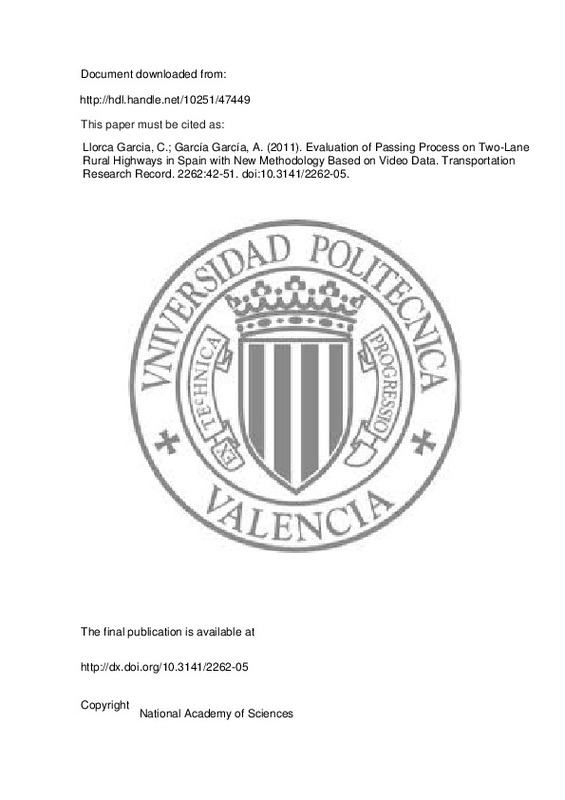JavaScript is disabled for your browser. Some features of this site may not work without it.
Buscar en RiuNet
Listar
Mi cuenta
Estadísticas
Ayuda RiuNet
Admin. UPV
Evaluation of Passing Process on Two-Lane Rural Highways in Spain with New Methodology Based on Video Data
Mostrar el registro sencillo del ítem
Ficheros en el ítem
| dc.contributor.author | Llorca García, Carlos
|
es_ES |
| dc.contributor.author | García García, Alfredo
|
es_ES |
| dc.date.accessioned | 2015-02-24T18:16:31Z | |
| dc.date.available | 2015-02-24T18:16:31Z | |
| dc.date.issued | 2011-02 | |
| dc.identifier.issn | 0361-1981 | |
| dc.identifier.uri | http://hdl.handle.net/10251/47449 | |
| dc.description.abstract | Drivers need sufficient passing sight distance (PSD) to pass slower vehicles with safety. This distance can help to improve traffic operation on two-way, two-lane highways. Existing models propose different values of PSD because of different assumptions. In only some cases were these models based on field data of passing maneuvers. This research proposed the design of a methodology to observe passing maneuvers on existing highways with the help of six video cameras installed at a fixed point next to passing sections. The use of more cameras allows complete registration of trajectories along the entire passing zone, with uniform image resolution. The methodology was applied to register a sample of 234 maneuvers on four passing zones. Trajectories of 58 maneuvers were completely described and analyzed with specific restitution software. Results were compared with those from existing PSD models. The distances traveled proposed by the AASHTO model on the left lane were (a) similar to average observed distances when the passed vehicle was one truck and (b) between 50 and 100 m higher when one passenger car was passed. Higher differences, greater than 100 m, were found between measured data and the PSD model (published previously), especially at high design speeds. The observed average speed difference between passing and impeding vehicles was significantly higher than that in any model. Variables with the strongest influence on the time and distance traveled on the opposing lane were the type and speed of the passed vehicle and the length of the passing zone. Left-lane time and distance increase with this length. | es_ES |
| dc.language | Inglés | es_ES |
| dc.publisher | National Academy of Sciences | es_ES |
| dc.relation.ispartof | Transportation Research Record | es_ES |
| dc.rights | Reserva de todos los derechos | es_ES |
| dc.subject | Average speed | es_ES |
| dc.subject | Design speed | es_ES |
| dc.subject | Field data | es_ES |
| dc.subject | Fixed points | es_ES |
| dc.subject | Measured data | es_ES |
| dc.subject | Psd models | es_ES |
| dc.subject | Rural highways | es_ES |
| dc.subject | Sight distance | es_ES |
| dc.subject | Traffic operation | es_ES |
| dc.subject | Two-lane | es_ES |
| dc.subject | Two-lane highways | es_ES |
| dc.subject | Video data | es_ES |
| dc.subject | Automobiles | es_ES |
| dc.subject | Image resolution | es_ES |
| dc.subject | Vehicles | es_ES |
| dc.subject.classification | INGENIERIA E INFRAESTRUCTURA DE LOS TRANSPORTES | es_ES |
| dc.title | Evaluation of Passing Process on Two-Lane Rural Highways in Spain with New Methodology Based on Video Data | es_ES |
| dc.type | Artículo | es_ES |
| dc.identifier.doi | 10.3141/2262-05 | |
| dc.rights.accessRights | Abierto | es_ES |
| dc.contributor.affiliation | Universitat Politècnica de València. Instituto del Transporte y Territorio - Institut del Transport i Territori | es_ES |
| dc.contributor.affiliation | Universitat Politècnica de València. Departamento de Ingeniería e Infraestructura de los Transportes - Departament d'Enginyeria i Infraestructura dels Transports | es_ES |
| dc.description.bibliographicCitation | Llorca Garcia, C.; García García, A. (2011). Evaluation of Passing Process on Two-Lane Rural Highways in Spain with New Methodology Based on Video Data. Transportation Research Record. 2262:42-51. doi:10.3141/2262-05 | es_ES |
| dc.description.accrualMethod | S | es_ES |
| dc.relation.publisherversion | http://dx.doi.org/10.3141/2262-05 | es_ES |
| dc.description.upvformatpinicio | 42 | es_ES |
| dc.description.upvformatpfin | 51 | es_ES |
| dc.type.version | info:eu-repo/semantics/publishedVersion | es_ES |
| dc.description.volume | 2262 | es_ES |
| dc.relation.senia | 213867 | |
| dc.description.references | Farah, H., Bekhor, S., & Polus, A. (2009). Risk evaluation by modeling of passing behavior on two-lane rural highways. Accident Analysis & Prevention, 41(4), 887-894. doi:10.1016/j.aap.2009.05.006 | es_ES |
| dc.description.references | Rilett, L. R., Hutchinson, B. G., & Whitney, M. (1990). Mechanics of the passing maneuver and the impact of large trucks. Transportation Research Part A: General, 24(2), 121-128. doi:10.1016/0191-2607(90)90019-3 | es_ES |
| dc.description.references | Wang, Y., & Cartmell, M. P. (1998). New Model for Passing Sight Distance on Two-Lane Highways. Journal of Transportation Engineering, 124(6), 536-545. doi:10.1061/(asce)0733-947x(1998)124:6(536) | es_ES |
| dc.description.references | Polus, A., Livneh, M., & Frischer, B. (2000). Evaluation of the Passing Process on Two-Lane Rural Highways. Transportation Research Record: Journal of the Transportation Research Board, 1701(1), 53-60. doi:10.3141/1701-07 | es_ES |
| dc.description.references | Carlson, P., Miles, J., & Johnson, P. (2006). Daytime High-Speed Passing Maneuvers Observed on Rural Two-Lane, Two-Way Highway: Findings and Implications. Transportation Research Record: Journal of the Transportation Research Board, 1961, 9-15. doi:10.3141/1961-02 | es_ES |
| dc.description.references | Harwood, D. W., Gilmore, D. K., & Richard, K. R. (2010). Criteria for Passing Sight Distance for Roadway Design and Marking. Transportation Research Record: Journal of the Transportation Research Board, 2195(1), 36-46. doi:10.3141/2195-05 | es_ES |







![[Cerrado]](/themes/UPV/images/candado.png)

